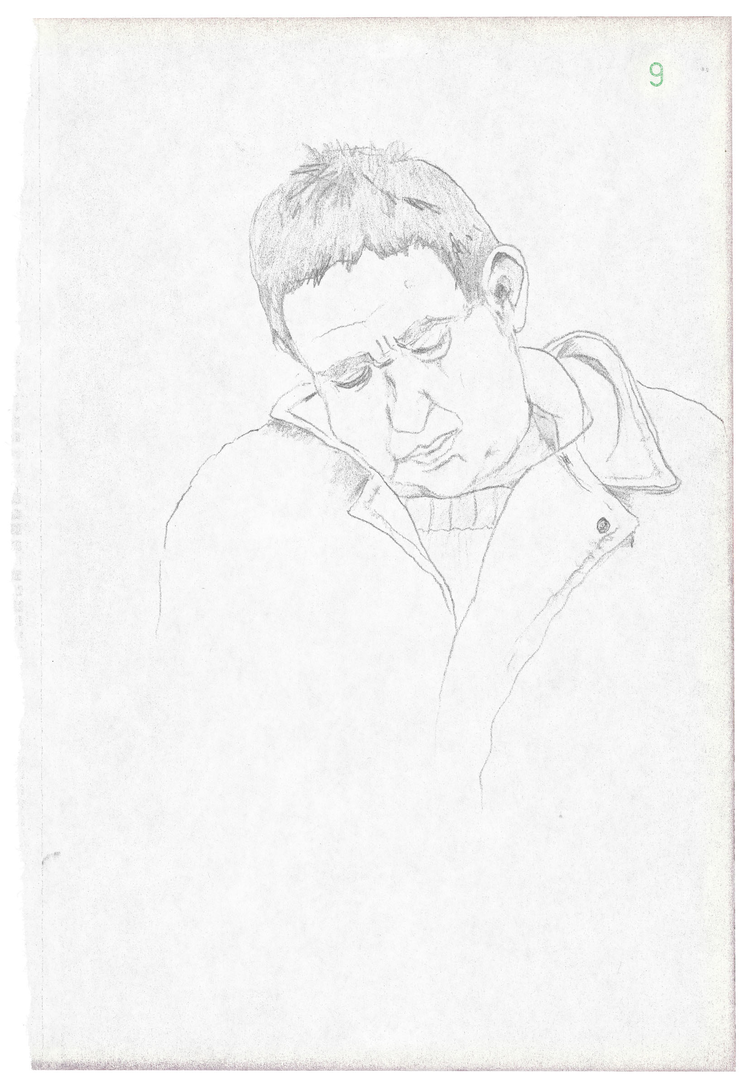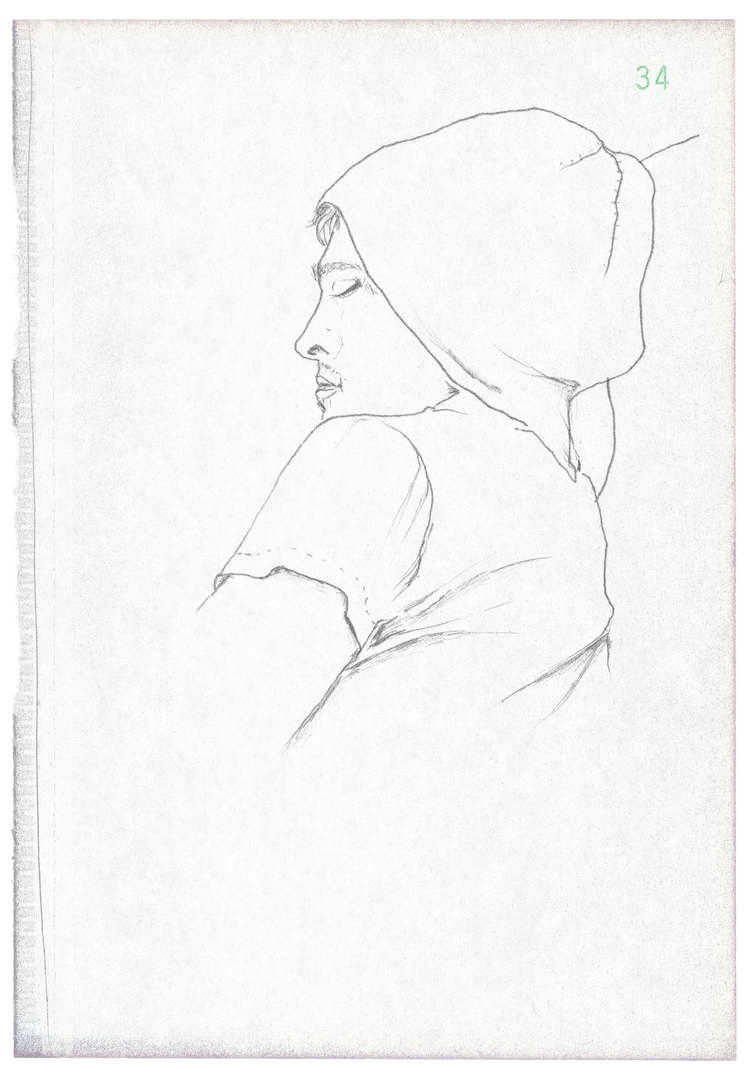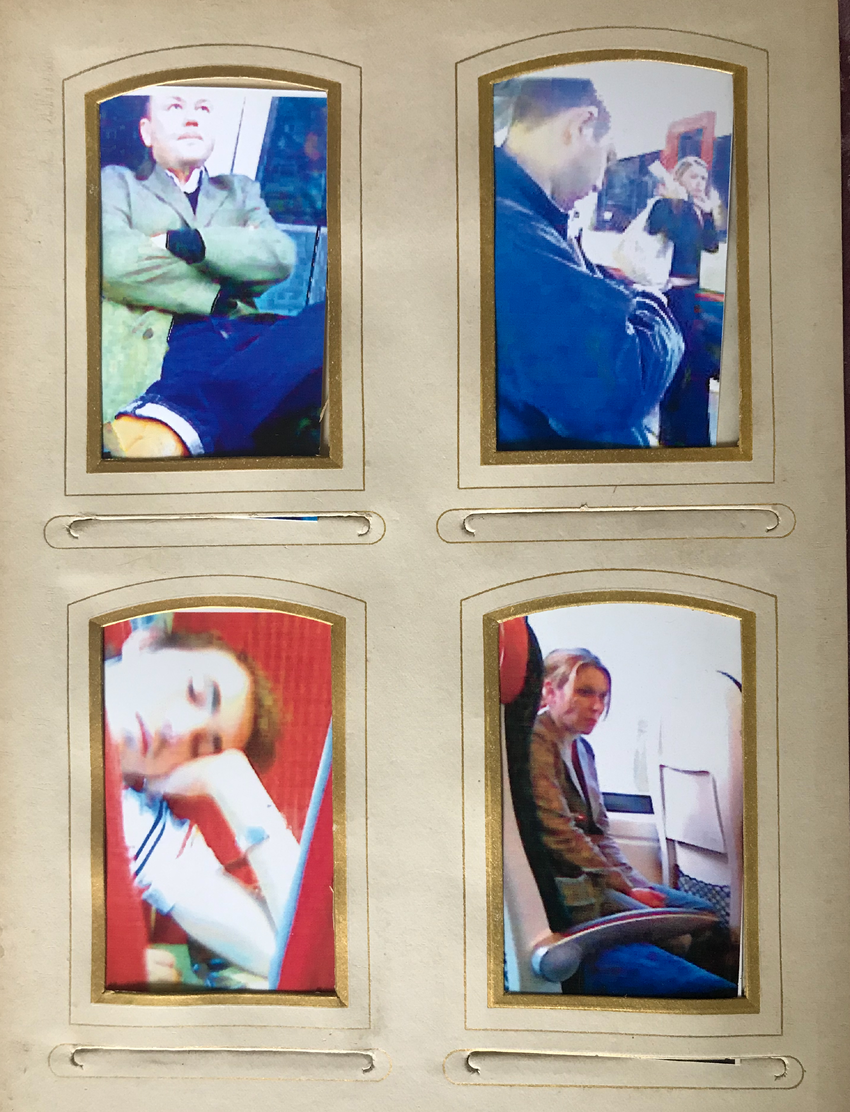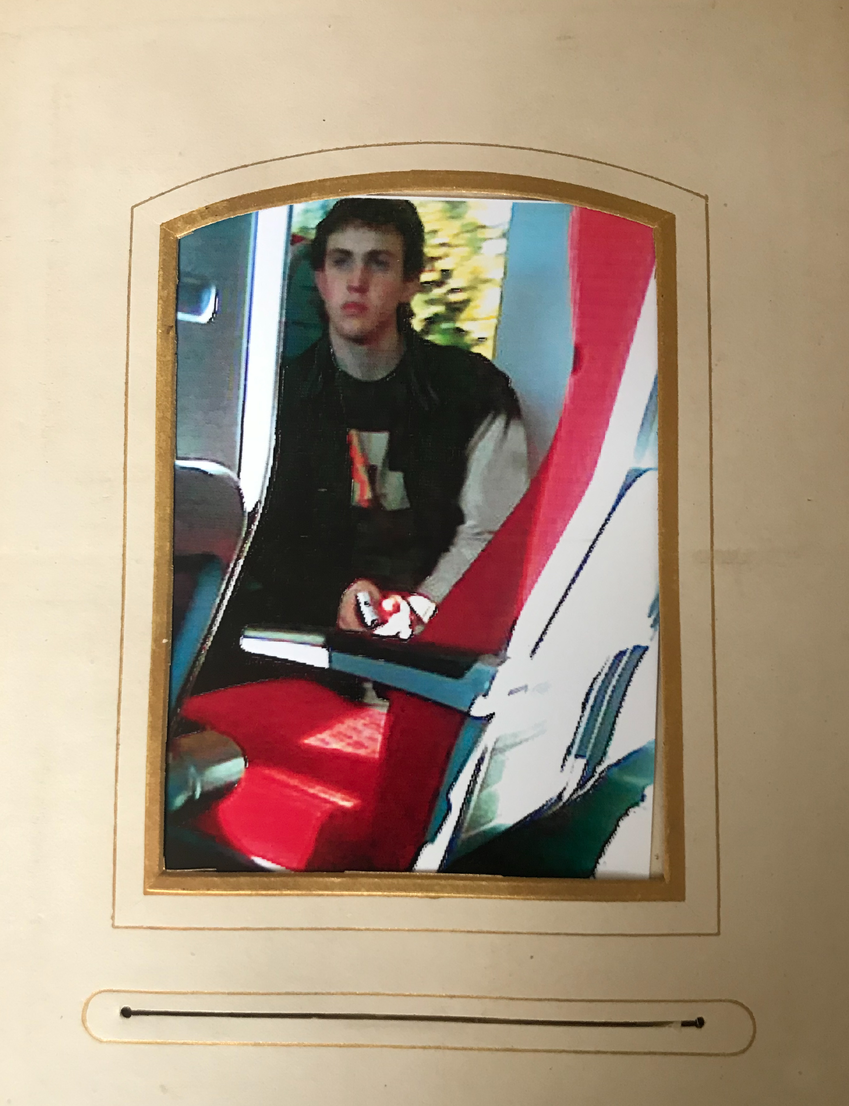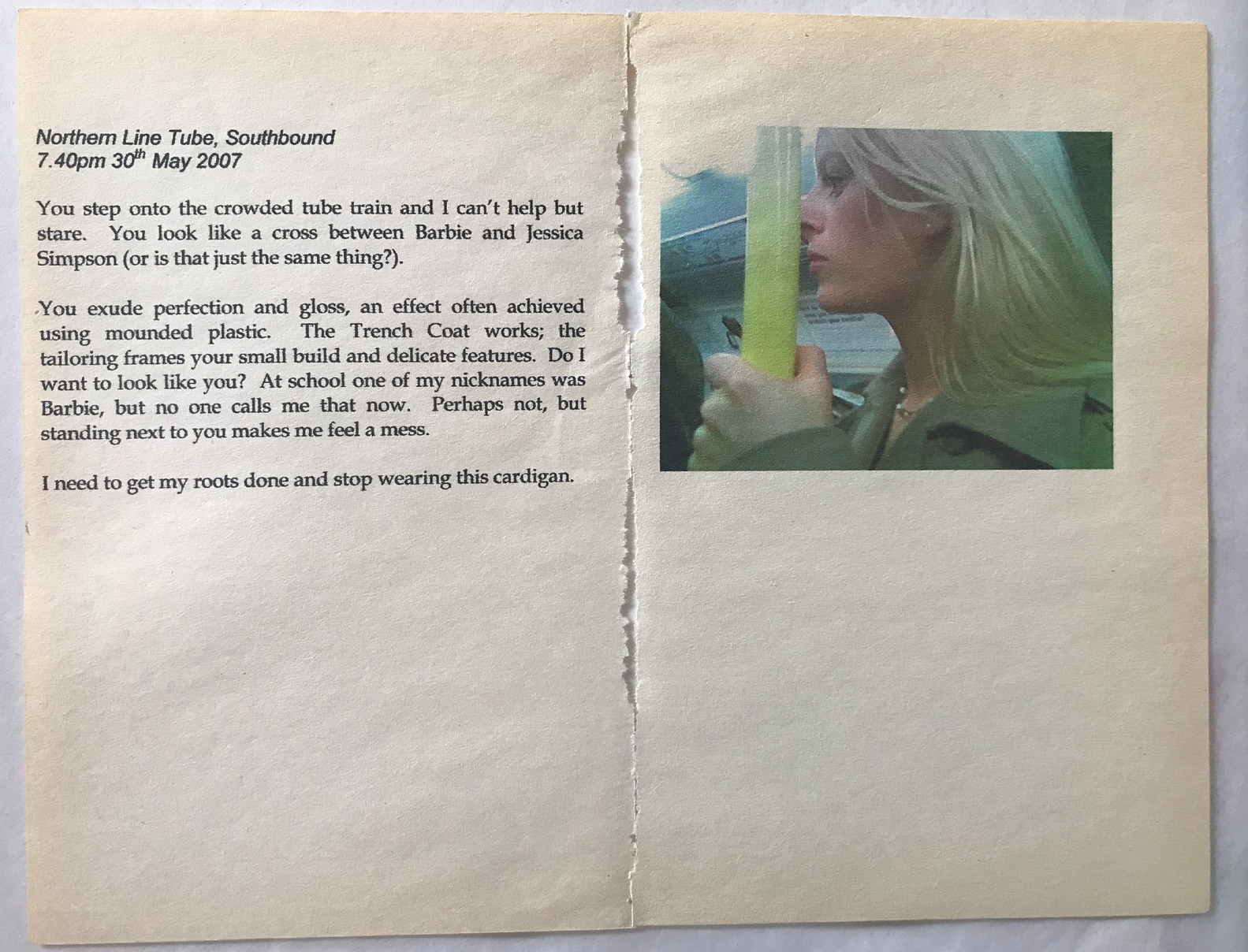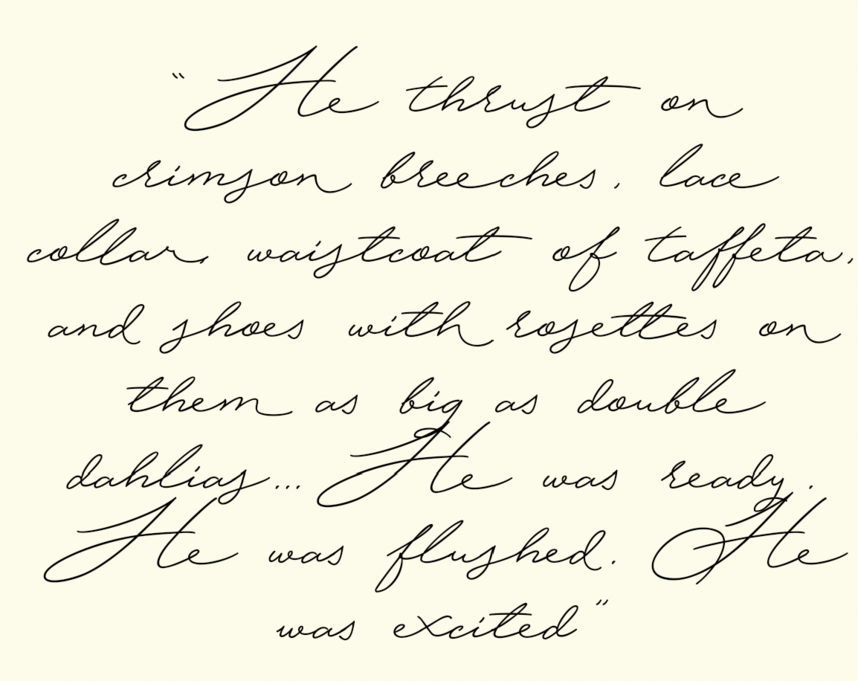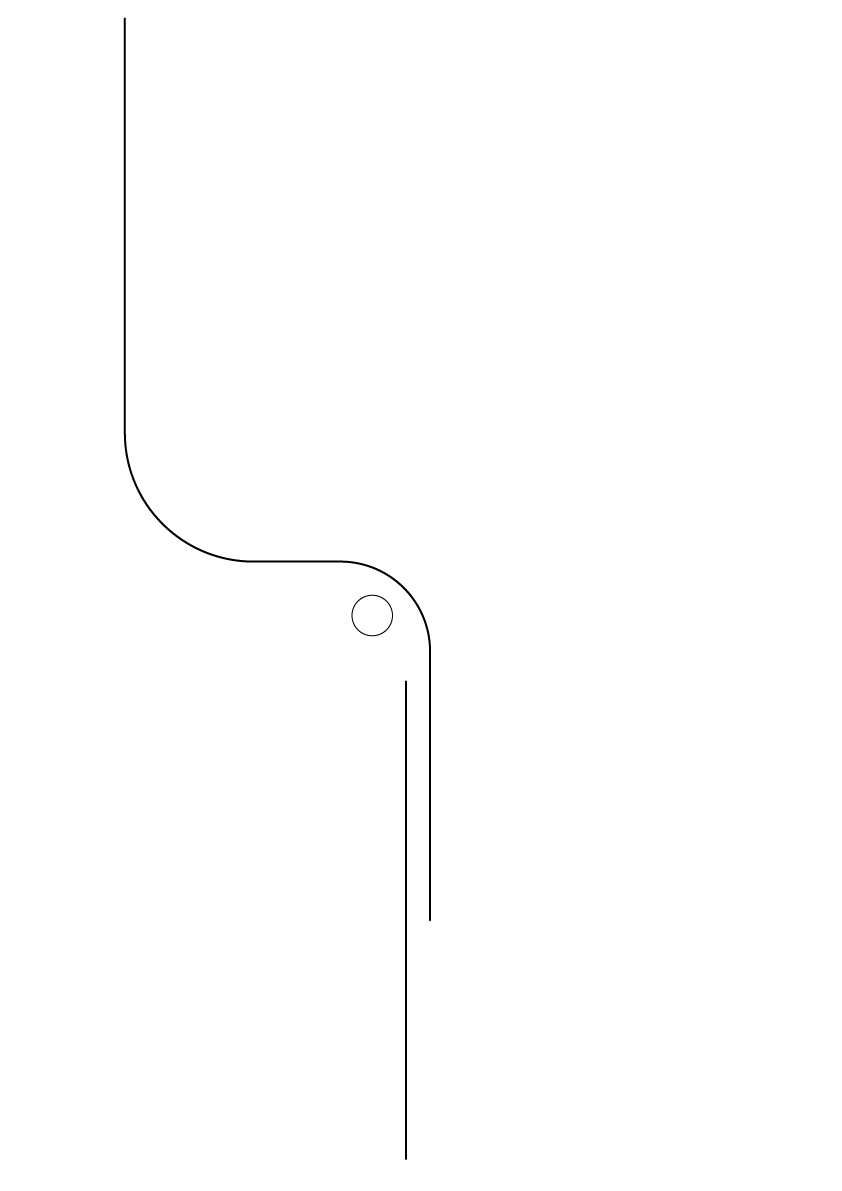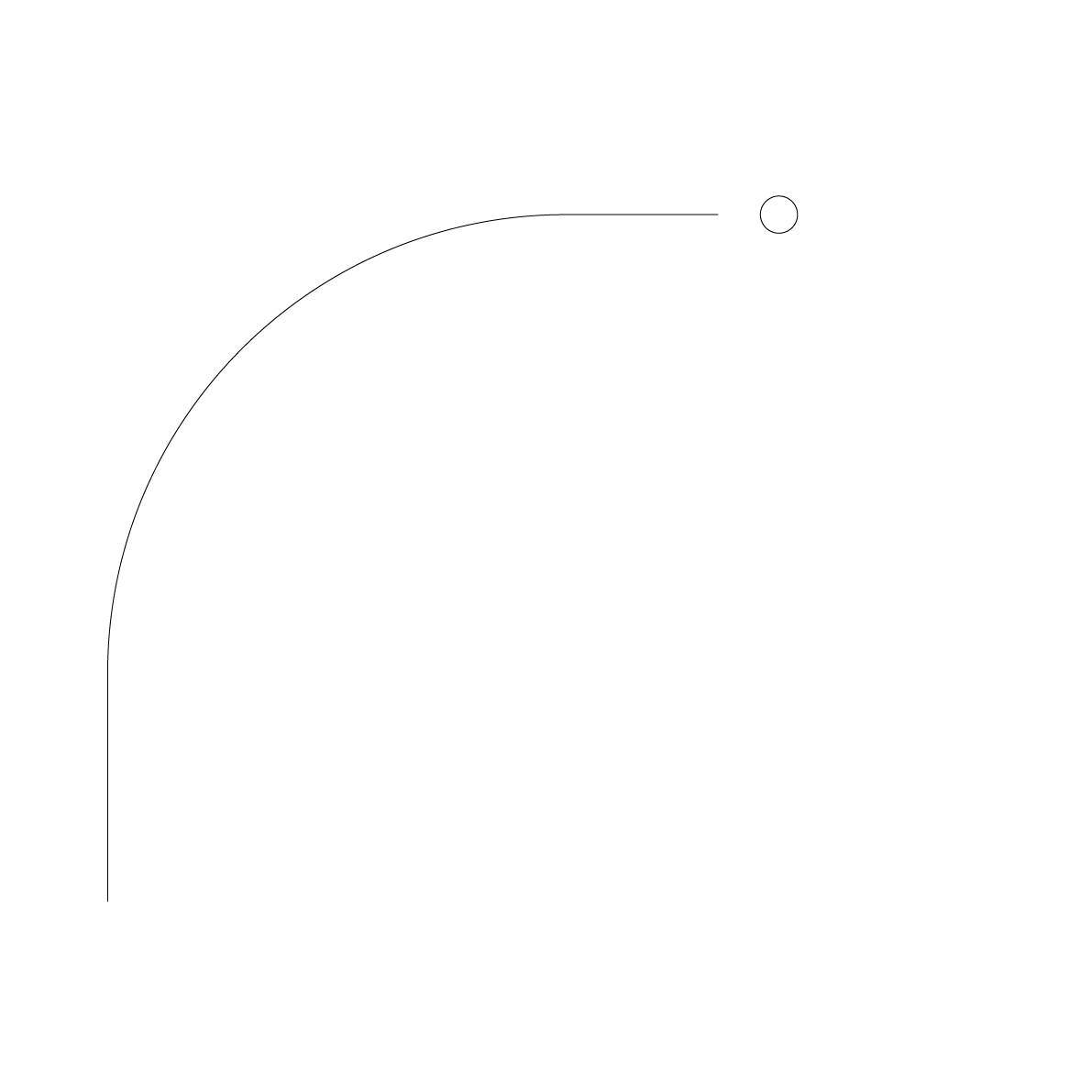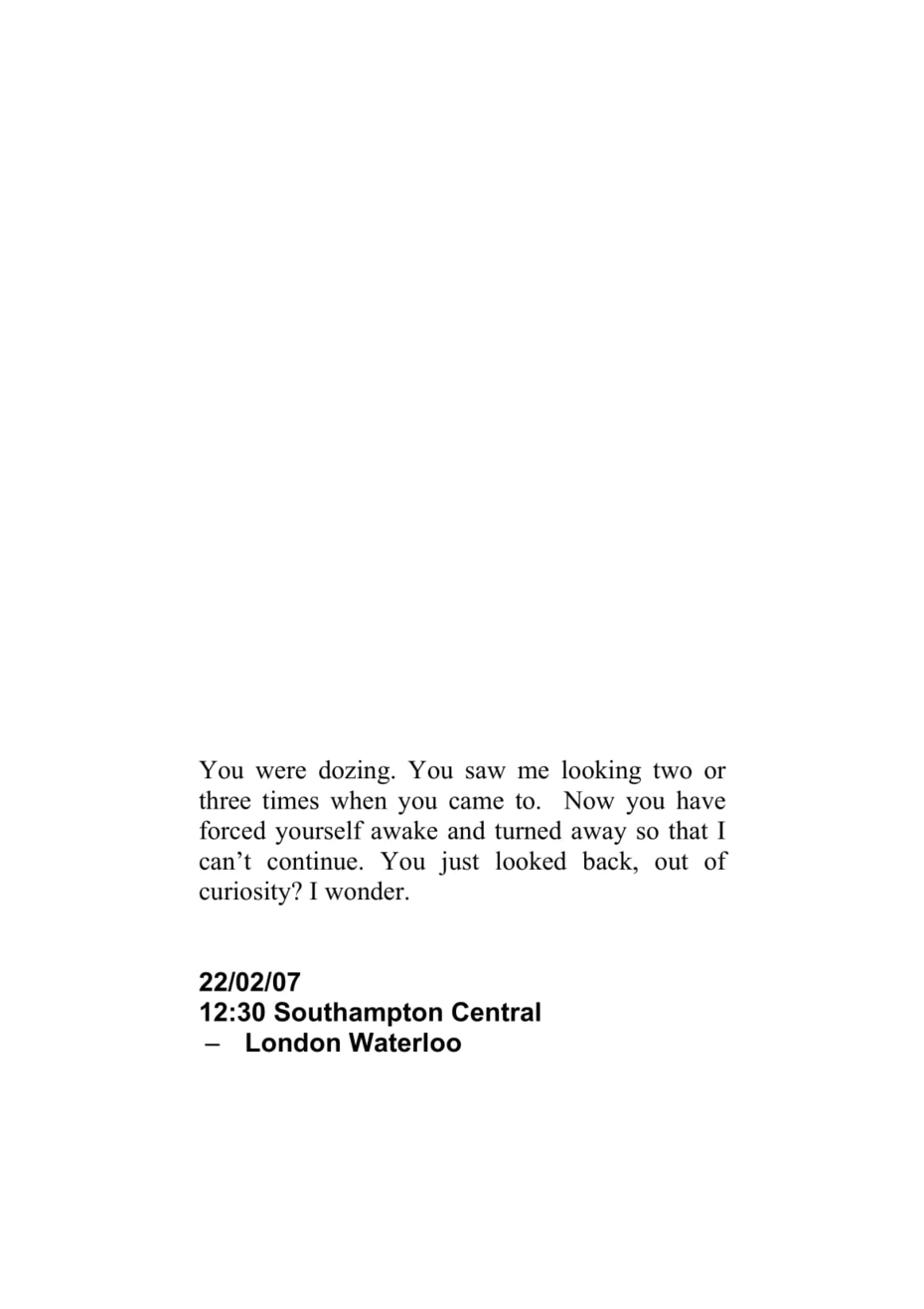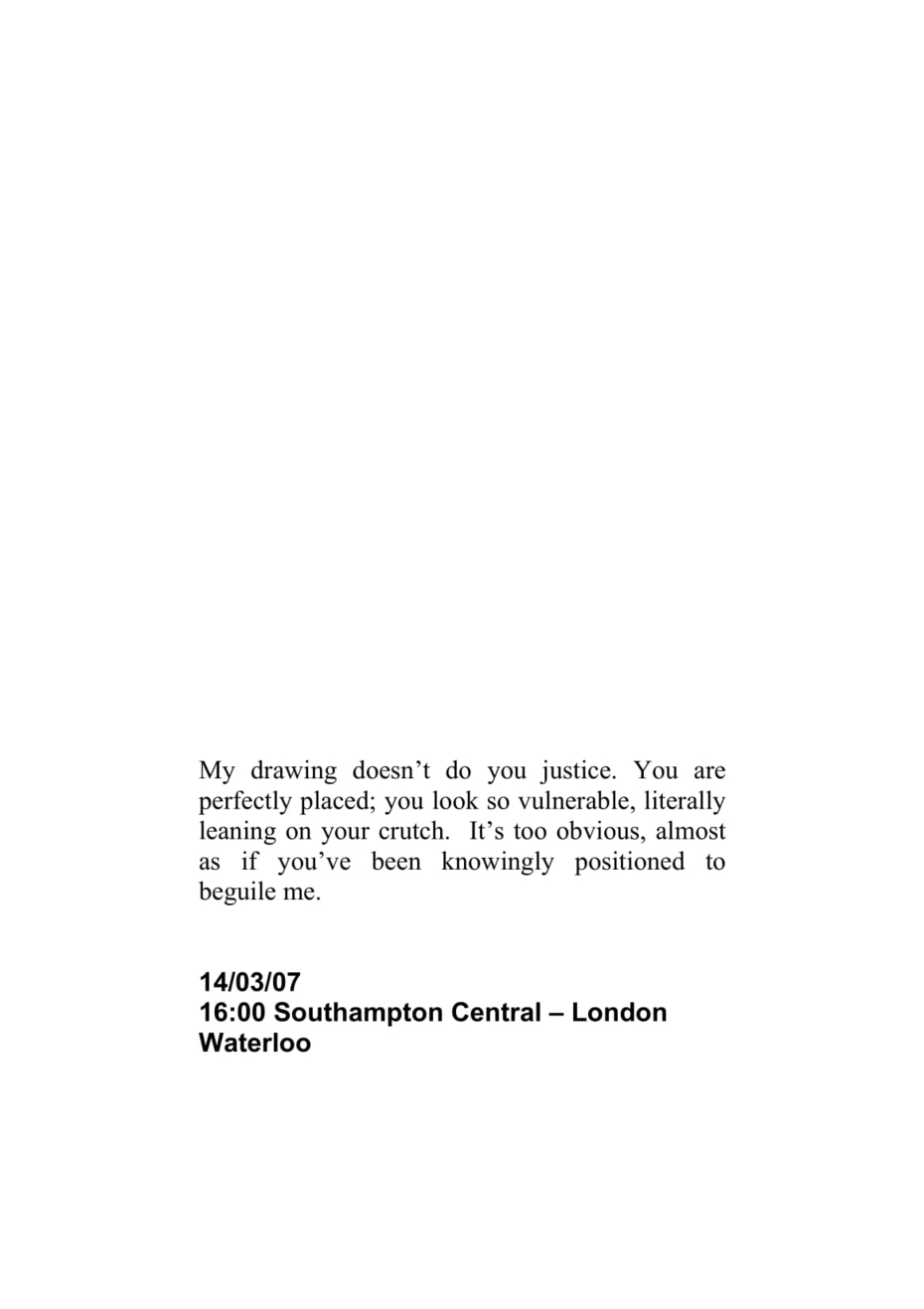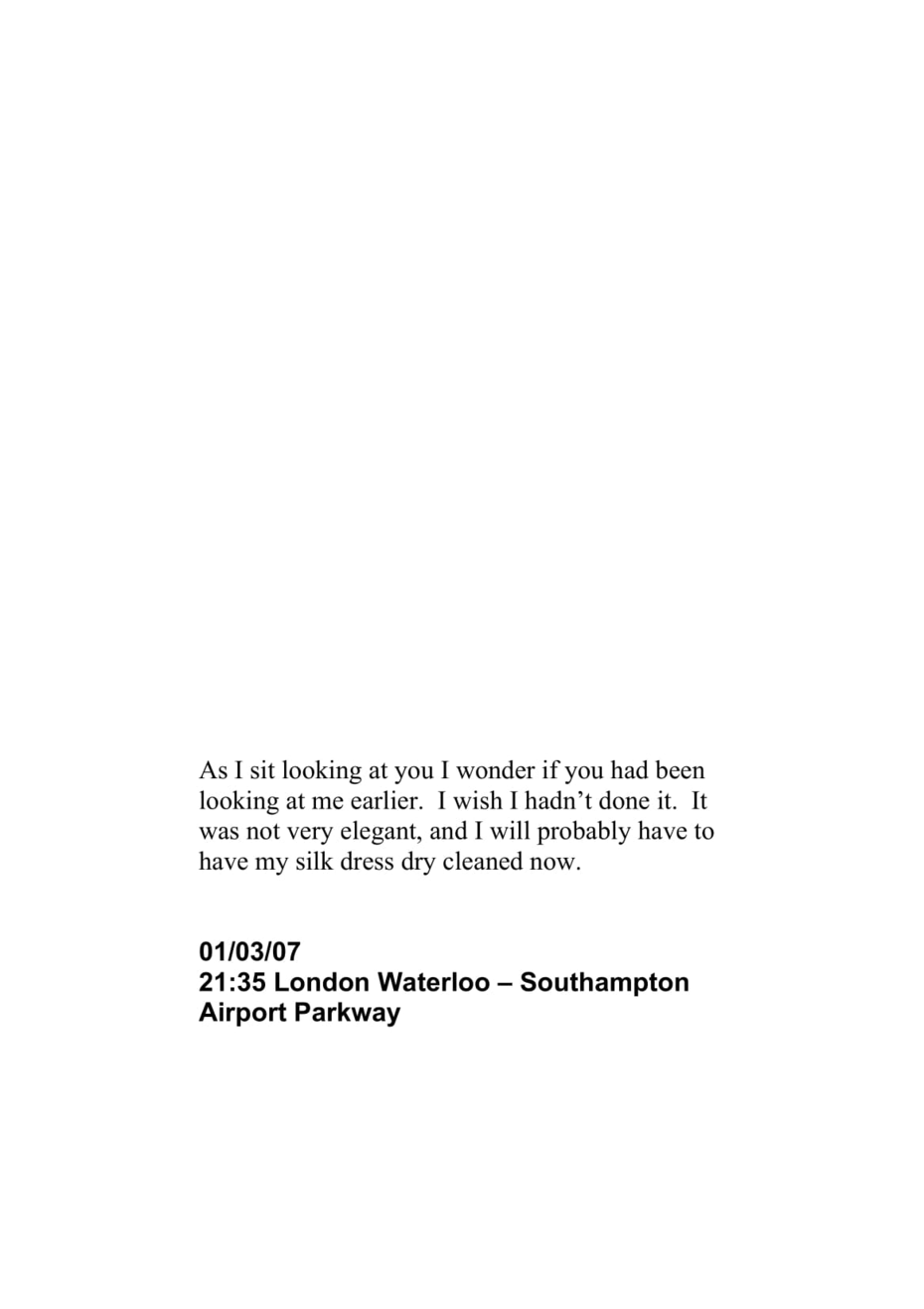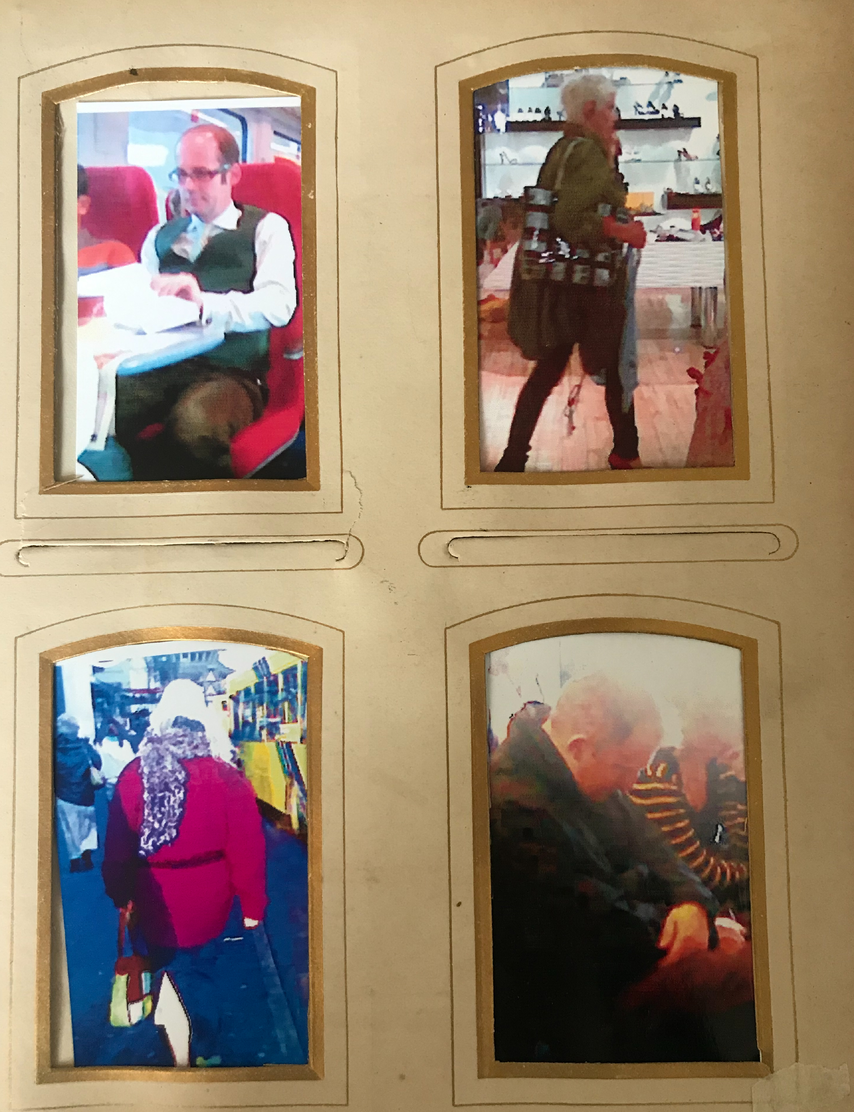At times in the Woolf's diaries there is also a sense of boredom conveyed, a wish for a desire, which leads into consciously trying to understand the effect of dressed bodies on one another, and on her own consciousness and sense of self; particularly when she is writing about Vita Sackville West:
Though Sackville West is not a stranger, Woolf contemplates her from a distance. She objectifies her to an extent and ruminates on what Sackville West might think of her from what Woolf perceives as her ‘glamourous, radiant’ position. Woolf’s description of Sackville West evidences the effect of Sackville West upon her (self) consciousness about her self presentation. The same affect is evidenced within this work, in response to the man in the velvet jacket. I record feeling startled and, in response to the woman on the tube who I describe as a ‘cross between Barbie and Jessica Simpson,’ I feel unkempt and dowdy. In both instances, I contemplate myself through an imagined mirror of their gaze.
Eroding the Otherness began as a piece of work in 2007 that produced a series of drawings, mobile phone photographs and a range of written documents that described individuals I encountered whilst travelling alone (in, out and around London) and my responses to them. The presentation of the work varies, employing a range of narrative devices such as the paperback novel page, a photograph album and duplicated images using carbon paper; all play with a sense of intimacy and distance.
A paper of the same name written as a piece of performative writing was published in Love on Trial
(Farghaly & Toralba 2011).
The structure of the paper (the observations in the main body and the theoretical notes contained within the footnotes) is intended to allow the paper to operate in two different ways. The paper can operate without the footnotes as a document of my practical research and a record of my dialogue with an imagined viewer (also the other) as well as myself, but with the footnotes as a research paper informed by critical discourse and theoretical issues pertinent to my area of research.
This definition succinctly describes my situation when on a train with no one to watch that interests me. Potential exists and, at any moment, I may notice someone whom I desire to record. However, for the majority of the time, this is not the case, and my observations are suspended: I am waiting for the desire to take hold. Phillips continues:
Sleepers, 2006-8
Pencil drawings and imprints from pencil drawings on carbon paper. I used a pad that had a carbon-coated page underneath each sheet of paper. I did this so that if challenged by a subject, I could offer the drawing to them, whilst retaining the copy for myself. I fantasised about the moment of being challenged, about how I would smile and offer the drawing to them, in a gesture of showing that I was not intending to ‘take’ anything, whilst knowing that I would still have the imprint beneath. No one ever challenged me, or even asked to see my drawings.
Without the footnotes, the observations are more open to interpretation and allow the reader to read ‘between the lines,’ to interpret different voices and aspects of consciousness. The intention is also to use the device of footnotes (and to some extent the preface) to make space for a second voice; a voice that is perhaps less self-assured than that of the person undertaking the practical research. The selves I explore within this paper can perhaps be seen as ‘narrator’ and ‘reflector’. The ‘narrator’ writes the observations at the time of observation, and the ‘reflector’ writes the footnotes. There is a clear temporal division between these two selves.
Within the act of observing and recording the other, and the resulting text, there is also a third self that I could call the ‘protagonist;’ the person undertaking the active observation of the other. Here I borrow the terms ‘narrator’ and ‘protagonist’ from Susannah Radstone, who uses them in in The Sexual Politics of Time (2007). It is somewhere between these three selves that self-transformation happens in response to the ‘other’ as well as the act of writing, allowing the paper to operate more fully as a confessional text.
The work, through the process of trying to be honest in my responses, teases out an uncomfortable experience of oscillating between objective and subjective - inner and outer worlds. My active use of an objectifying gaze and my feelings as the gaze turned back upon me.
Frock consciousness is a state affected by a number of factors, and these individual factors can play a bigger or smaller part in consciousness at any given time. Frock consciousness (like fashion) is temporary, it can be just a moment, it can endure somewhat, but our frock consciousness does not remain as a consistent state, we change clothes, our environment changes, our bodies change. As this project developed and my behaviour became bolder and more extreme, I began to explore how I was empowered within the non-place to behave in an almost predatory manner, outside of my social world, taking risks and enjoying the adrenalin I created by obviously prolonging my gaze and recording a person. It was no coincidence that I pursued my activities more vehemently as my pregnancy progressed. I came to believe that, as a pregnant woman, I was almost untouchable in my ability to take risks. In terms of my behaviour in public space, I flouted what might be considered polite or normal.
Inkjet print mobile phone photographs, second-hand photograph album, 2008
Through placing the photographs in an album, I was implying that the images were precious and part of a personal narrative.
The sartorial descriptions underpin the lavish flourishes of the character, aligned not only to social status and the occasion of attending a banquet, but also to Orlando’s personality. The imagery of crimson breeches, lace ruffs and extravagantly large rosettes on the shoes serve to illustrate the extravagant nature of Orlando’s character and approach to the world; he is excessively masculine, at this point in the narrative, embracing the flourishes of peacocking masculinity that might be seen as clothing as an enabling device, affecting mood, imbuing one with an essence of what is required for the moment.
When I encounter strangers, I encounter at first a fashioned body - a site of non-verbal communication. This is the visual object of desire that I respond to, I never, ever spoke to my subjects. As Phillips describes, I wait for myself, a moment when I react, shift, feel something.
Sylvia Plath, in her journal of 1959 (2001: 20) describes pregnancy as ‘nine months of becoming something other’. I was acutely aware of the finite period in which I had this other body at my disposal. It was critical that I undertook autoethnography at that stage because I would only ever have a limited opportunity to mine my own experience of that state. Later it can be reflected upon and read around, drawing upon the experiences of others, but there is limited opportunity to research and document the carnal feeling, and in constructing this exposition I realise that this is a distinct body of work that I do not have the space to elaborate on here.
[1] The terms ‘narrator’ and ‘protagonist’ are used by Radstone in The Sexual Politics of Time (Routledge, 1993)
The confession moreover, presents the telling of itself as the source of self-transformation: the confession describes and performs the becomingness (Radstone's emphasis) which constitutes its very heart. (1993: 36)
…the bored child is waiting, unconsciously for an experience of anticipation… not exactly waiting for someone else, he is, as it were, waiting for himself…
(1993: 72).
A feeling of boredom or malaise, in terms of mental uneasiness, recurs throughout the work; this relates to the continuous undercurrent of desire or a wish for desire to take hold. At times when boredom prevails, it is because action and interest have been suspended. Adam Phillips writes about boredom in childhood in his essay, On Being Bored:
Pregnant women are generally viewed as vulnerable, to be protected (to protect the child within). This is the opposite of how we might view a predator, someone who threatens to take something from us. So, I got close, I drew, I photographed, I made eye contact whilst doing so, and nobody ever asked what I was doing. I was never confronted and the more frequently I tested this theory, the more I was emboldened to continue. I used what in retrospect I call the ‘cloak of pregnancy’ this is my term in reference to Jane Lazar’s term ‘the cloak of parenthood’ (2001: 64). When in that cloak, be it of pregnancy or parenthood, one’s physical state is often overwhelmed, affecting not only how others see us but how we see ourselves. I saw myself as untouchable in my pregnancy cloak; many of these photographs and text works were made during this time.
I include the work Sleepers within the exposition because it represents an important starting point to my conception of ‘frock consciousness’. The methodology for the project was quite simple. Using the non-space of public transport and spaces such as stations as my field, I selected individuals to watch, draw, write about and occasionally follow, almost entirely based upon their appearance; I was responding to strangers who pricked my consciousness. I followed a time-limited process of observing a stranger using drawing, mobile phone photography, writing notes and occasionally voice recording my thoughts in order to document my stream of consciousness in response to the person and the situation of gazing upon them. This would end when my journey or their journey ended and one of us left. This structure allowed me to dwell upon a stranger in a way that, as we navigate our typical day to day lives, we do not usually have the time for. I discovered with certainty that, at each moment, I was changed by the person I gazed upon. I shifted in response to them, I was affected; the body of work serves as a document of this collection of moments.
I use the format of confession to explore the power relationship between myself and the other. The unison of the confessional structure and the duality, that exists within the interplay between the body of the text and the footnotes, allows for a developmental process. Mark Freeman discusses how this is formed through recognition and articulation; ‘the concept of the self is very much informed by time and place’ (1993: 27, his emphasis), and describes how ‘[t]he concept of the self …hovers in the space between recollection and development’ (1993: 48-9). I am associating this mental space with a real physical space (the non-place of the train, station, tube and bus) by using that designated time and space, with all the experiential possibilities that it offers, as a place in which to reflect upon the self (myself), and the impact of experiencing the other. I am also exploring the experience of being other, through my responses to my encounters with the other, that cause me to constantly rewrite myself. This reflective style of writing is closely associated with the practice of writing a journal or a diary. It is apparent that it is within the reflective space of Woolf’s diaries that she unravels concepts and ideas, including ‘frock consciousness.’ She does this by reflecting upon her own experience of social spaces and the encounters within them. Her reflections upon experience and effect of clothing are used to explore and give substance to characters, her depiction of sartorial details enact aspects of character, such as this description of Orlando rushing to dress for a banquet:









